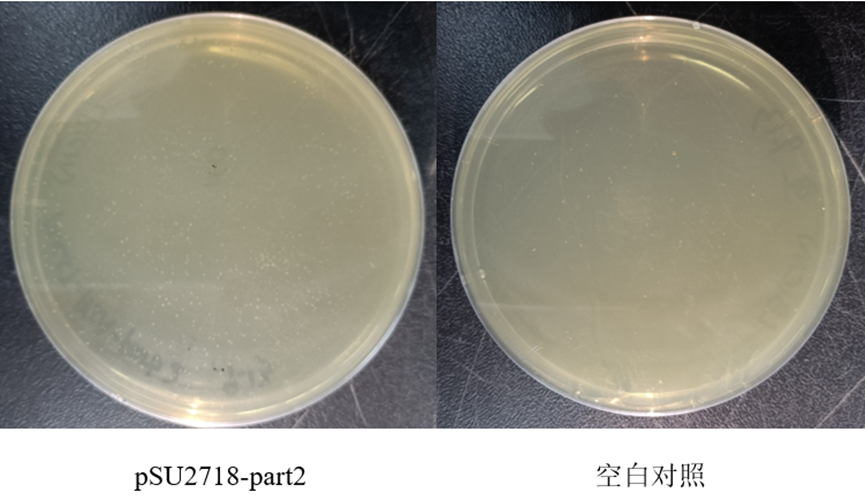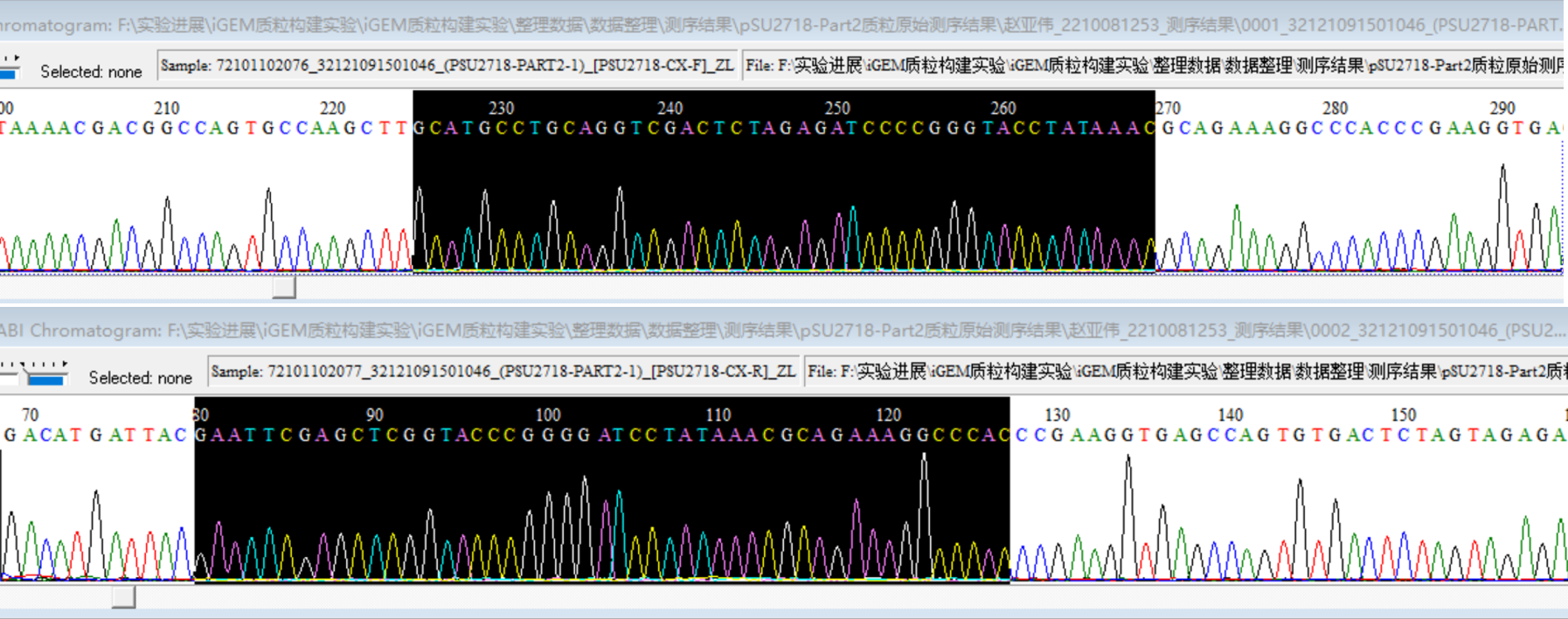Difference between revisions of "Part:BBa K3994012"
| Line 3: | Line 3: | ||
<partinfo>BBa_K3994012 short</partinfo> | <partinfo>BBa_K3994012 short</partinfo> | ||
| − | PttB344 | + | promoter |
| + | |||
| + | === Profile === | ||
| + | |||
| + | ==== Name: PttB344 ==== | ||
| + | ==== Base Pairs: 85bp ==== | ||
| + | ==== Origin: Synthetic ==== | ||
| + | ==== Properties: A coding sequence of promoter ttB344. ==== | ||
| + | |||
| + | === Usage and Biology === | ||
| + | |||
| + | This is a sequence of PttB344. PttrB185-269 is a minimal TtrR activated promoter when TtrR is phosphorylated by TtrS after TtrS sensing tetrathionate. | ||
| + | |||
| + | === Experimental approach === | ||
| + | |||
| + | |||
| + | ==== Recombinant Plasmid Construction ==== | ||
| + | |||
| + | [[File:T--NOFLS YZ--BBa K3994001-Figure1.png|500px|thumb|center|Figure 1. The electrophoresis results of enzyme digestion and PCR...]] | ||
| + | |||
| + | Lane 1 and 2: Plasmid pSU2718-p15A digested by Xba1 and BamH1. | ||
| + | |||
| + | Lane 3: Part 2, PttB344_HrpS_PJ23105_ttrR, got by PCR method with size of 2060bp. | ||
| + | |||
| + | This step is used to get the plasmids pSU2718-p15A digested by enzyme Xba1 and BamH1and gene PttB344_HrpS_PJ23105_ttrR by PCR method for later in the process. Therefore, channel 1 and 2 were plasmids pSU2718-p15A digested by enzyme Xba1 and BamH1. And channel 3 were gene PttB344_HrpS_PJ23105_ttrR got by PCR. Clean-up the product to obtain pSU2718-p15A backbone and PttB344_HrpS_PJ23105_ttrR-fragment. | ||
| + | |||
| + | T4 DNA ligase is used to connect pSU2718-p15A backbone and PttB344_HrpS_PJ23105_ttrR-fragment to get plasmid pSU2718-part2. | ||
| + | |||
| + | |||
| + | [[File:T--NOFLS YZ--BBa K3994001-Figure2.png|500px|thumb|center|Figure 2 E-coil having the desired pSU2718-part2 (Left) and control (Right)...]] | ||
| + | |||
| + | |||
| + | [[File:T--NOFLS YZ--BBa K3994001-Figure5.0.png|500px|thumb|center|Figure 3. The electrophoresis result of enzyme digestion identification...]] | ||
| + | |||
| + | [[File:T--NOFLS YZ--BBa K3994001-Figure3.png|500px|thumb|center|Figure 3. The electrophoresis result of enzyme digestion identification...]] | ||
| + | |||
| + | Lane 1: Plasmid pSU2718-p15A digested by EcoR1. | ||
| + | |||
| + | Lane 2 to 5: Recombinant plasmid pSU2718-part2 digested by EcoRI. We got two bands with size of 2803bp and 1544bp. | ||
| + | The results show that we got the correct plasmid. And the plasmid was sent to sequence. | ||
| + | |||
| + | [[File:T--NOFLS YZ--BBa K3994001-Figure4.png|500px|thumb|center|Figure 4 The result of sequencing for plasmid pSU2718-part2...]] | ||
| + | |||
| + | |||
| + | Sequencing feedback shows we have obtained the correct plasmids which is consistent with their DNA profiles. | ||
| + | |||
| + | === Proof of function === | ||
| + | |||
| + | ==== Attempt 1 ==== | ||
| + | |||
| + | [[File:T--NOFLS YZ--BBa K3994003-Figure5.jpg|500px|thumb|center|Figure 5. Genetic Construction of IBD Distinguisher...]] | ||
| + | |||
| + | |||
| + | Sample 1: Negative Control (E. coli) | ||
| + | |||
| + | Sample 2: Positive Control (E. coli/amilGFP) | ||
| + | |||
| + | Sample 3: E. coli/pUC-57_Part 3 | ||
| + | |||
| + | Sample 4: E.coli/pSU2718-Part 1_Part 2+pUC-57_Part 3 | ||
| + | |||
| + | |||
| + | In order to further analyze the performance of Part 2, we also designed the control groups as showing above where Sample 1 and Sample 2 were presented as the comparison of the fluorescence phenomenon. We can see that there was no fluorescence in Sample 3 (the report part, Part 3). According to the result of Sample 3 and Sample 4 (Figure 5), we could infer that the AND gate design works (HrpR_HrpS, PhrpL) as the Part 3 didn’t respond when there is no Part 1 and Part 2. | ||
| + | |||
| + | Of course, we also repeated the experiments and measured the fluorescence intensity by ELIASA. The data is given below. | ||
| + | |||
| + | |||
| + | [[File:T--NOFLS YZ--BBa K3994003-table2.png|500px|thumb|center|Table 2...]] | ||
| + | |||
| + | |||
| + | [[File:T--NOFLS YZ--BBa K3994003-Figure6.png|500px|thumb|center|Figure 6. Histograms of the fluorescence intensity of samples in Table 2...]] | ||
| + | |||
| + | [[File:T--NOFLS YZ--BBa K3994003-Figure7.png|500px|thumb|center|Figure 7. Trend Contrast of the fluorescence intensity between that under OD600=0.8 and that under OD600=1..]] | ||
| + | |||
| + | |||
| + | According to the trend in Figure 7, the fluorescence intensity of pUC57-Part 3 presents the similar level as that of blank control and group NO3-, which means the “gate keeper” promoter, PhrpL works well and this conclusion also back up the conclusion that the AND gate design works well (HrpR_HrpS, PhrpL). | ||
| + | |||
| + | |||
| + | As the group S4O62 did present higher fluorescence intensity than that of group NO3- whenever OD600 equals to 0.8 or 1, it indicates that Part 2 and Part 3 both works well as Part 2 did show “green light” to the thiosulfate to finally “light” the Part 3. | ||
| + | |||
| + | |||
<!-- Add more about the biology of this part here | <!-- Add more about the biology of this part here | ||
Latest revision as of 12:42, 19 October 2021
PttB344
promoter
Profile
Name: PttB344
Base Pairs: 85bp
Origin: Synthetic
Properties: A coding sequence of promoter ttB344.
Usage and Biology
This is a sequence of PttB344. PttrB185-269 is a minimal TtrR activated promoter when TtrR is phosphorylated by TtrS after TtrS sensing tetrathionate.
Experimental approach
Recombinant Plasmid Construction
Lane 1 and 2: Plasmid pSU2718-p15A digested by Xba1 and BamH1.
Lane 3: Part 2, PttB344_HrpS_PJ23105_ttrR, got by PCR method with size of 2060bp.
This step is used to get the plasmids pSU2718-p15A digested by enzyme Xba1 and BamH1and gene PttB344_HrpS_PJ23105_ttrR by PCR method for later in the process. Therefore, channel 1 and 2 were plasmids pSU2718-p15A digested by enzyme Xba1 and BamH1. And channel 3 were gene PttB344_HrpS_PJ23105_ttrR got by PCR. Clean-up the product to obtain pSU2718-p15A backbone and PttB344_HrpS_PJ23105_ttrR-fragment.
T4 DNA ligase is used to connect pSU2718-p15A backbone and PttB344_HrpS_PJ23105_ttrR-fragment to get plasmid pSU2718-part2.
Lane 1: Plasmid pSU2718-p15A digested by EcoR1.
Lane 2 to 5: Recombinant plasmid pSU2718-part2 digested by EcoRI. We got two bands with size of 2803bp and 1544bp. The results show that we got the correct plasmid. And the plasmid was sent to sequence.
Sequencing feedback shows we have obtained the correct plasmids which is consistent with their DNA profiles.
Proof of function
Attempt 1
Sample 1: Negative Control (E. coli)
Sample 2: Positive Control (E. coli/amilGFP)
Sample 3: E. coli/pUC-57_Part 3
Sample 4: E.coli/pSU2718-Part 1_Part 2+pUC-57_Part 3
In order to further analyze the performance of Part 2, we also designed the control groups as showing above where Sample 1 and Sample 2 were presented as the comparison of the fluorescence phenomenon. We can see that there was no fluorescence in Sample 3 (the report part, Part 3). According to the result of Sample 3 and Sample 4 (Figure 5), we could infer that the AND gate design works (HrpR_HrpS, PhrpL) as the Part 3 didn’t respond when there is no Part 1 and Part 2.
Of course, we also repeated the experiments and measured the fluorescence intensity by ELIASA. The data is given below.
According to the trend in Figure 7, the fluorescence intensity of pUC57-Part 3 presents the similar level as that of blank control and group NO3-, which means the “gate keeper” promoter, PhrpL works well and this conclusion also back up the conclusion that the AND gate design works well (HrpR_HrpS, PhrpL).
As the group S4O62 did present higher fluorescence intensity than that of group NO3- whenever OD600 equals to 0.8 or 1, it indicates that Part 2 and Part 3 both works well as Part 2 did show “green light” to the thiosulfate to finally “light” the Part 3.
Sequence and Features
- 10COMPATIBLE WITH RFC[10]
- 12COMPATIBLE WITH RFC[12]
- 21COMPATIBLE WITH RFC[21]
- 23COMPATIBLE WITH RFC[23]
- 25COMPATIBLE WITH RFC[25]
- 1000COMPATIBLE WITH RFC[1000]









